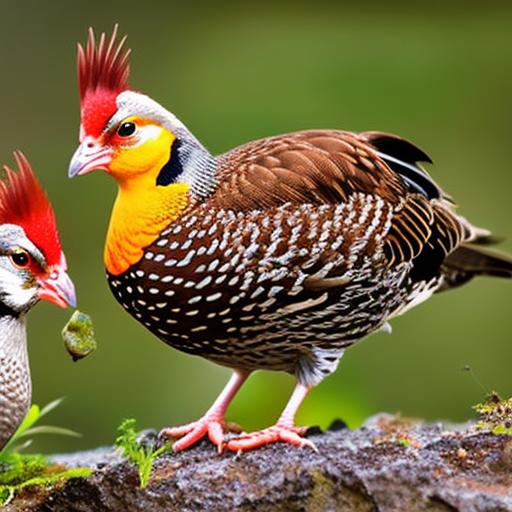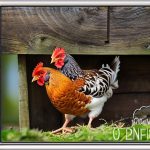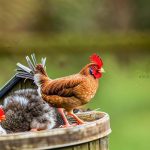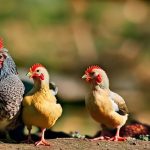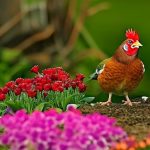Japanese quail and chickens are both popular poultry species that are often kept together by backyard farmers and hobbyists. Japanese quail, also known as Coturnix quail, are small birds native to East Asia. They are known for their high egg production, fast growth rate, and adaptability to various climates. Chickens, on the other hand, are domesticated birds that come in various breeds and sizes. They are primarily kept for their eggs, meat, or as pets.
One of the reasons why people keep Japanese quail and chickens together is because they can coexist in the same living space without any major issues. Both species have similar housing requirements and can tolerate each other’s presence. Additionally, keeping them together can be beneficial in terms of space utilization and social interaction.
Key Takeaways
- Japanese quail and chickens are popular poultry species for backyard farming.
- Understanding the behavior of both species is important for successful integration.
- Housing requirements for Japanese quail and chickens differ, but they can be housed together if done properly.
- Proper feeding and nutrition are essential for the health and productivity of both species.
- Health and disease management, breeding and reproduction, and egg production are important factors to consider when keeping Japanese quail and chickens.
Understanding the Behavior of Japanese Quail and Chickens
While Japanese quail and chickens may share some similarities in behavior, there are also notable differences between the two species. Quail are generally more flighty and skittish compared to chickens. They have a strong instinct for self-preservation and tend to be more alert and wary of their surroundings. Chickens, on the other hand, are more social and tend to form hierarchical structures within their flock.
When kept together, Japanese quail and chickens may interact with each other in various ways. Chickens may exhibit curiosity towards the quail, while the quail may be more cautious around the larger birds. It is not uncommon for chickens to peck at the quail out of curiosity or territorial behavior. However, with proper introduction and adequate space, these interactions can be minimized.
Compatibility of Japanese Quail and Chickens
Before deciding to keep Japanese quail and chickens together, there are several factors that need to be considered. Firstly, it is important to ensure that the housing setup can accommodate both species comfortably. The space should be large enough to allow for free movement and provide separate areas for feeding and nesting.
When introducing quail to an existing chicken flock, it is crucial to monitor their interactions closely. Chickens may initially show aggression towards the quail, especially if they perceive them as intruders. Gradual introductions and providing visual barriers can help reduce stress and prevent any potential harm to the quail.
Housing Requirements for Japanese Quail and Chickens
Both Japanese quail and chickens have similar housing requirements, making it easier to keep them together. The ideal housing setup should provide protection from predators, adequate ventilation, and sufficient space for the birds to move around.
For Japanese quail, a wire mesh cage or aviary is commonly used. The cage should have a solid floor to prevent injuries to their delicate feet. It is important to provide nesting boxes or areas where the quail can lay their eggs comfortably.
Chickens, on the other hand, require a coop with nesting boxes and perches. The coop should be well-ventilated and have enough space for the chickens to move around freely. It is also important to provide a secure outdoor area where the chickens can roam during the day.
When keeping quail and chickens together, it is recommended to have separate areas within the housing setup for feeding and nesting. This helps prevent competition for resources and reduces the risk of aggression between the two species.
Feeding and Nutrition for Japanese Quail and Chickens
Japanese quail and chickens have different dietary needs, so it is important to provide them with appropriate feed. Quail require a high-protein diet, especially during their egg-laying period. A commercial game bird feed or a mix of grains and seeds can meet their nutritional requirements.
Chickens, on the other hand, require a balanced diet that includes grains, protein sources (such as soybean meal), and calcium for egg production. A commercial layer feed is commonly used for chickens, but it is important to supplement their diet with fresh greens and occasional treats.
It is important to provide separate feeding areas for quail and chickens to prevent competition and ensure that each species gets the appropriate nutrition. Water should also be provided at all times, and it is recommended to use shallow dishes or waterers to prevent drowning accidents.
Health and Disease Management for Japanese Quail and Chickens
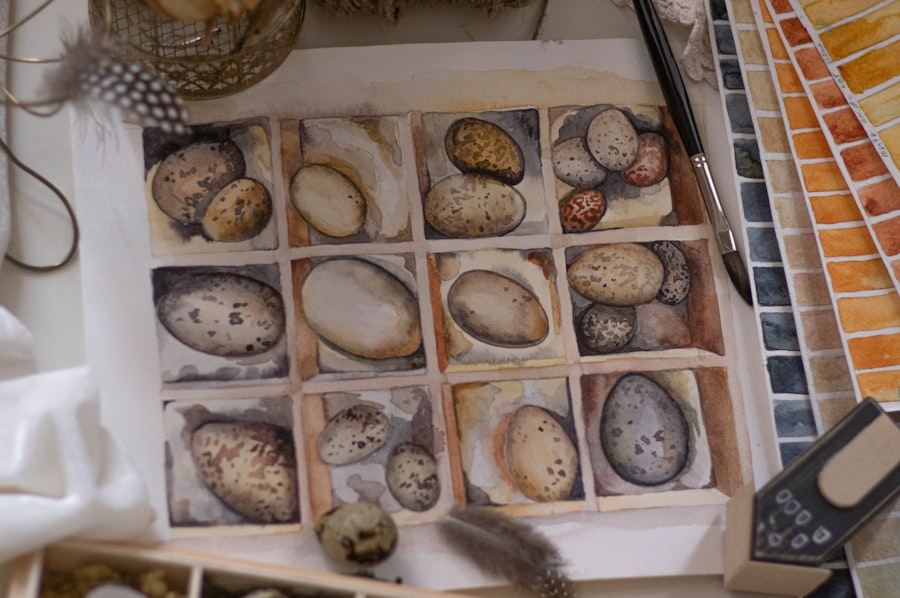
Both Japanese quail and chickens are susceptible to various health issues, so it is important to implement proper health management practices. Common health issues for quail include respiratory infections, parasites, and egg binding. Chickens, on the other hand, may suffer from respiratory diseases, mites, and egg-related problems.
To prevent illnesses, it is important to maintain a clean and hygienic living environment for the birds. Regular cleaning of the housing setup, proper waste management, and regular health checks can help identify and address any potential health issues.
If a bird shows signs of illness, it is important to isolate it from the rest of the flock and seek veterinary advice. Treatment options may include medication, dietary adjustments, or supportive care.
Breeding and Reproduction of Japanese Quail and Chickens
Breeding Japanese quail and chickens can be a rewarding experience for poultry enthusiasts. Both species have relatively short breeding cycles and can produce offspring within a few weeks.
To breed Japanese quail, it is important to provide them with suitable nesting areas where they can lay their eggs. The eggs should be collected daily to prevent them from being damaged or eaten by the birds. Incubation of quail eggs typically takes around 17-18 days, after which the chicks will hatch.
Chickens have a longer breeding cycle compared to quail. The hens will lay eggs in nesting boxes, and if a rooster is present, the eggs may be fertilized. The incubation period for chicken eggs is around 21 days, after which the chicks will hatch.
Egg Production and Quality in Japanese Quail and Chickens
Japanese quail are known for their high egg production, with some individuals capable of laying up to 300 eggs per year. The eggs are small in size, typically weighing around 10-12 grams each. Quail eggs have a delicate flavor and are often used in gourmet cooking.
Chickens, on the other hand, have varying egg production rates depending on the breed. Some breeds are known for their high egg production, while others are more suitable for meat production. Chicken eggs come in various sizes and colors, ranging from small to extra-large.
To ensure high-quality eggs from both quail and chickens, it is important to provide them with a balanced diet, clean nesting areas, and regular collection of eggs. Proper storage of the eggs is also important to maintain their freshness and quality.
Benefits and Drawbacks of Keeping Japanese Quail with Chickens
Keeping Japanese quail with chickens has its pros and cons. One of the main benefits is space utilization. By keeping both species together, farmers can maximize the use of their available space and resources.
Another benefit is social interaction. Chickens are social animals that thrive in the presence of other birds. By keeping quail with chickens, the birds can interact with each other, providing mental stimulation and reducing boredom.
However, there are also drawbacks to consider. Chickens may exhibit aggressive behavior towards quail, especially during the initial introduction phase. This can result in injuries or stress for the quail. Additionally, quail may be more prone to diseases carried by chickens, so proper biosecurity measures should be implemented.
Tips for Successful Integration of Japanese Quail and Chickens
To ensure a smooth integration process between Japanese quail and chickens, it is important to follow these tips:
1. Gradual introduction: Start by keeping the quail and chickens in separate enclosures within the same area. This allows them to get used to each other’s presence without direct contact.
2. Visual barriers: Use wire mesh or fences to create visual barriers between the quail and chickens. This allows them to see and smell each other without direct physical contact.
3. Provide separate feeding and nesting areas: Ensure that each species has their own designated areas for feeding and nesting. This helps prevent competition and reduces the risk of aggression.
4. Monitor interactions closely: Keep a close eye on the interactions between the quail and chickens during the integration process. If any signs of aggression or stress are observed, separate them immediately.
5. Provide ample space: Make sure that the housing setup provides enough space for both quail and chickens to move around comfortably. Overcrowding can lead to stress and aggression.
If problems arise during the integration process, it may be necessary to separate the quail and chickens permanently. Not all birds will get along, and it is important to prioritize their safety and well-being.
Keeping Japanese quail with chickens can be a rewarding experience for poultry enthusiasts. By understanding their behavior, providing suitable housing, and meeting their dietary needs, it is possible to successfully keep these two species together. However, it is important to consider the compatibility of the birds, monitor their interactions closely, and be prepared to separate them if necessary. With proper care and management, keeping Japanese quail with chickens can be a fulfilling and enjoyable endeavor.
If you’re considering keeping Japanese quail with chickens, it’s important to ensure they have suitable living conditions. One article that provides valuable insights into creating a harmonious environment for both species is “The Chicken Coop Country Diner” by Poultry Wizard. This article discusses the benefits of having a well-designed coop that accommodates different types of poultry, including quail and chickens. It offers practical tips and ideas for creating a coop that promotes the well-being and productivity of all your feathered friends. Check out the article here to learn more about how to keep Japanese quail and chickens together successfully.
FAQs
What are Japanese quails?
Japanese quails are small birds that are native to East Asia. They are commonly kept as domesticated birds for their meat and eggs.
Can Japanese quails be kept with chickens?
Yes, Japanese quails can be kept with chickens. However, it is important to ensure that the quails have enough space and resources to thrive alongside the chickens.
What are the benefits of keeping Japanese quails with chickens?
Keeping Japanese quails with chickens can provide a number of benefits, including increased egg production and pest control. Quails are also known to be hardy birds that can withstand a variety of environmental conditions.
What are the potential drawbacks of keeping Japanese quails with chickens?
One potential drawback of keeping Japanese quails with chickens is that the quails may be more susceptible to disease and parasites than the chickens. Additionally, quails may require different feed and housing requirements than chickens.
What should be considered when keeping Japanese quails with chickens?
When keeping Japanese quails with chickens, it is important to ensure that the birds have enough space and resources to thrive. This may include providing separate feeders and waterers for the quails, as well as ensuring that the housing is suitable for both species. Additionally, it is important to monitor the birds for signs of disease or stress.
Meet Walter, the feathered-friend fanatic of Florida! Nestled in the sunshine state, Walter struts through life with his feathered companions, clucking his way to happiness. With a coop that’s fancier than a five-star hotel, he’s the Don Juan of the chicken world. When he’s not teaching his hens to do the cha-cha, you’ll find him in a heated debate with his prized rooster, Sir Clucks-a-Lot. Walter’s poultry passion is no yolk; he’s the sunny-side-up guy you never knew you needed in your flock of friends!

